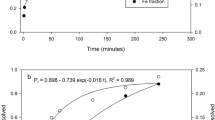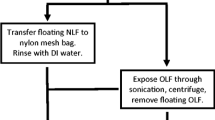Abstract
We used 16 soils to compare the Hedley method for soil phosphorus fractionation to an alternative method recently developed by Ruttenberg to differentiate among P fractions in marine sediments. For forms of labile and Fe-bound P in soils, these methods were poorly correlated, with the Hedley fractionation showing a greater ability to discriminate among variations in plant-available P. For Ca-bound P, total organic P, and total P, the methods were well correlated (r2=0.93, 0.48, 0.74, respectively), although the sum of P measured in the Ruttenberg extractions is only 45% of the total P recovered by the Hedley fractionation. The Hedley fractionation seems superior when an index of plant-available phosphorus and a separation of organic and inorganic forms is needed, whereas the Ruttenberg method allows a separation of CaCO3-bound P from apatite-P, which is potentially useful in calcareous soils.
Similar content being viewed by others
References
Aspila KI, Agemian H & Chau ASY (1976) A semi-automatic method for the determination of inorganic, organic and total phosphate in sediments. Analyst 101: 187–197
Bowman RA, Olson SR & Watanabe FS (1978) Greenhouse evaluation of residual phosphate by four phosphorus methods in neutral and calcareous soils. Soil Sci. Soc. America J. 42: 451–454
Chang SC & Jackson ML (1956) Fractionation of soil phosphorus. Soil Science 84: 133–144
Cross AF & Schlesinger WH (1995) A literature review and evaluation of the Hedley fractionation: Applications to the biogeochemical cycle of soil phosphorus in natural ecosystems. Geoderma 64:197–214
D'Elia CF, Steudler PA & Corwin N (1977) Determination of total nitrogen in aqueous samples using persulfate digestion. Limnol. Oceanography 22: 760–764
Gallardo A & Schlesinger WH (1994) Factors limiting microbial biomass in the mineral soil and forest floor of a warm-temperate forest. Soil Biol. Biochem. 26: 1409–1415
Hedley MJ, Stewart JWB & Chauhan BS (1982) Changes in inorganic soil phosphorus fractions induced by cultivation practices and by laboratory incubations. Soil Sci. Soc. America J. 46: 970–976
Hook PB, Burke IC & Lauenroth WK (1991) Heterogeneity of soil and plant N and C associated with individual plants and openings in North American shortgrass steppe. Plant and Soil 138: 247–256
Kumar V, Gilkes RJ & Bolland MDA (1992) A comparison of seven soil P tests for plant species with different external P requirements grown on soils containing rock phosphate and superphosphate residues. Fertilizer Res. 33: 35–45
Lajtha K & Schlesinger WH (1988) The biogeochemistry of phosphorus cycling and phosphorus availability along a desert soil chronosequence. Ecology 69: 24–39
Lichter J (1998) Rates of weathering and chemical depletion in soils across a chronosequence of Lake Michigan sand dunes. Geoderma 85: 255–282
Martin JM, Nirel P & Thomas AJ (1987) Sequential extraction techniques: promises and problems. Marine Chem. 22: 313–341
Murphy J & Riley J (1962) A modified single solution for the determination of phosphate in natural waters. Analytica Chimica Acta 27: 31–36
Pettersson K & Istvanovics V (1988) Sediment phosphorus in Lake Balaton — forms and mobility. Ergebn. Limnol. 30: 25–41
Potter RL, Jordan, CF, Guedes RM, Batmanian GJ & Han XG (1992) Assessment of a phosphorus fractionation method for soils: problems for further investigation. Agriculture, Ecosystems, and Environment 34: 453–463
Qualls RG & Richardson CJ (1995) Forms of soil phosphrous along a nutrient enrichment gradient in the northern everglades. Soil Science 160: 183–198
Ruttenberg KC (1992) Development of a sequential extraction method for different forms of phosphorus in marine sediments. Limnology and Oceanography 37: 1460–1482
Saggar S, Hedley MJ & White RE (1992) Development and evaluation of an improved soil test for phosphorus: The influence of phosphorus fertilizer solubility and soil properties on the extractability of soil phosphorus. Fertilizer Res. 33: 81–91
Schlesinger WH, Fonteyn PJ & Reiners WA (1989a) Effects of overland flow on plant water relations, erosion, and soil water percolation on a Mojave desert landscape. Soil Sci. Soc. America J. 53: 1567–1572
Schlesinger WH, DeLucia EH & Billings WD (1989b) Nutrient-use efficiency of woody plants on contrasting soils in the western Great Basin, Nevada. Ecology 70: 105–113
Schlesinger WH, Raikes JA, Hartley AE & Cross AF (1996) On the spatial pattern of soil nutrients in desert ecosystems. Ecology 77: 364–374
Schlesinger WH, Bruijnzeel LA, Bush MB, Klein EM, Mace KA, Raikes JA & Whittaker RJ (1998) The biogeochemistry of phosphorus after the first century of soil development on Rakata Island, Krakatau, Indonesia. Biogeochemistry 40: 37–55
Shapiro L (1967) Rapid analysis of rocks and minerals by a single-solution method. U.S. Geological Survey Professional Paper 575-B: 187–191
Tiessen H & Moir JO (1993) Characterization of available P by sequential extraction. In: Carter MR (Ed) Soil Sampling and Methods of Analysis (pp 75–86). Lewis Publishers, Ann Arbor
Williams JDH, Syers JK, Harris RF & Armstrong DE (1971) Fractionation of inorganic phosphate in calcareous lake sediments. Soil Sci. Soc. America Proc. 35: 250–255
Author information
Authors and Affiliations
Rights and permissions
About this article
Cite this article
Levy, E.T., Schlesinger, W.H. A comparison of fractionation methods for forms of phosphorus in soils. Biogeochemistry 47, 25–38 (1999). https://doi.org/10.1007/BF00993095
Accepted:
Issue Date:
DOI: https://doi.org/10.1007/BF00993095




